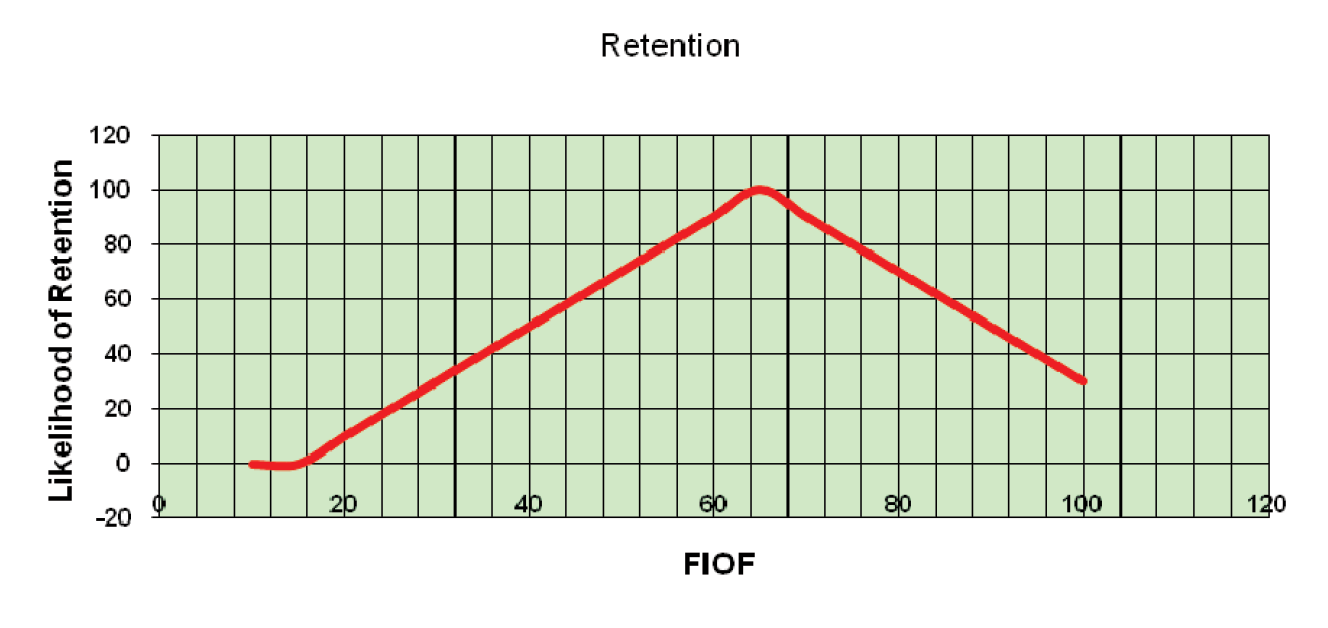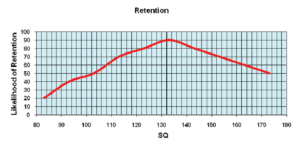
Between 1985 and 2010, my continued research, assessments, studies and analyses of more than 500,000 salespeople and sales managers, has yielded consistent, predictive recommendations about the performance of salespeople.
My White Paper, The Science of Salesperson Selection, discusses the research and methods employed over the past two decades to consistently improve and perfect the assessments provided by Objective Management Group, Inc.
My most recent study and analysis has shed light on some of the characteristics that determine longevity, or to use a more familiar concept, turnover prevention. Turnover, whether voluntary or involuntary, occurs when one party, either the employer or employee, is unhappy with the other. More often than not, the turnover is voluntary, and the employee resigns when income, culture, degree of difficulty or management practices are not to the salesperson’s liking. Involuntary turnover occurs less often because most sales managers are too patient, accept mediocrity, and avoid confrontation, especially a potentially uncomfortable termination. Our statistics show that:
- 20% of sales managers have need for approval – the need to be liked – and shy away from confrontation.
- 30% of sales managers accept mediocrity, and tolerate poor performance.
- 61% of sales managers aren’t inclined to upgrade their sales force.
- 60% of sales managers have less than 65% of the attributes of accountability.
We live in an era where employees no longer remain with a company for most of their lives. It is not unusual for a younger employee to work for several companies before they turn 30. Today, turnover is inevitable and when you consider the unique dynamic of the odds of a salesperson succeeding, the risk of expensive turnover increases dramatically.
It is important for a company to know its New Salesperson Return on Investment (NSROI). NSROI answers the question of how long a new salesperson must remain with a company in order for the investment of time and money to produce an acceptable return and for the salesperson to have an impact.
Once a company understands its NSROI, the amount of time the salesperson must be retained, the next question is
whether we can predict how long a successful salesperson is likely to stay.
I have identified 5 factors that influence and can be used to predict longevity:
1. Figure it Out Factor (FIOF) – I developed this important score in 2009 to determine how much more quickly an assessed salesperson, recommended for hire, would ramp up than a typical salesperson. Salespeople with scores of greater than 75 ramp up significantly faster than those with lower scores. Salespeople with scores of less than 50 ramp up significantly more slowly than those with higher scores. FIOF was a surprise finding in this study. In the context of Longevity, FIOF is a reverse finding where those with FIOF scores of higher than 75 were LESS likely to be retained, while those with scores of less than 75 were twice as likely to be retained for at least 5 years! See the graph below. In the case of retention, those who achieve overnight success tend to look for the next challenge more quickly than those who are slow and steady. Showing these talented salespeople a career path with growth opportunities, more responsibility, and promotions can offset the risk of losing “A” players too quickly.

2. Sales Quotient (SQ) – In the 1990’s our team developed a scoring system to rank hirable candidates. A perfect SQ is 173 and over achievers usually have SQ’s of more than 145. In the context of Sales Longevity, SQ is another reverse finding where those with SQ’s of greater than 145 were LESS likely to be retained, while those with scores of between 110 and 130 were more likely to be retained for at least 5 years! See the graph below. It is more difficult to retain A Players than B players!

3. Supervision – Managers factor in to this equation too. Sales Managers who closely managed their salespeople were 91% more likely to retain them than their peers who practiced a hands-off approach. While closely managing salespeople is a sales management best practice, it must add value to the salesperson. Sales Managers must be able to effectively coach, mentor, motivate, challenge and develop these salespeople to increase their levels of success and earnings.
4. Experience – Salespeople with experience – at least 5 years – are much more likely to be retained for 5 years than salespeople with less experience.
5. Compensation – Salespeople who are compensated mostly by commission are twice more likely to be
retained than salespeople who are compensated mostly by salary
The impact on Longevity by some of the findings above, like experience, are intuitive while some, like Sales Quotient, are counter-intuitive. When considered cumulatively, these findings bring us close to a prediction but in order to more accurately predict Sales Longevity, we need to revisit NSROI. The greater the number of years required to achieve NSROI, the less likely a salesperson is to be retained for that long.
In order to calculate NSROI we need to include the following variables:
Ramp Up Time – this important formula that I developed during the 1990’s, has three variables of its own:
1. LOSC – Length of the Sales Cycle in Months
2. LOLC – Length of the Learning Curve (number of months until a new salesperson can have an intelligent conversation with a prospect about your products/services)
3. TP – The Transition Period (usually 30 Days)
The Formula to identify Ramp Up Time (the amount of time before a new salesperson can be expected to generate consistent revenue, and transition from subsidized to self-generated compensation) is: LOSC + LOLC + TP. For example, if you have an 8-month sales cycle, your learning curve is 3 months, and we add 1 month for the transition, the Ramp Up Time is one year. Once we know the Ramp Up Time expectations about the new salesperson’s performance can be set. While you would have to be patient – for a year – before you begin to see consistent results, you would be guilty of allowing mediocrity or failure if you show too much patience. If you show too little patience you won’t allow the salesperson enough time to succeed. It’s important to point out that the patience applies only to revenue, not to the activity required to develop a growing pipeline!
Months to Break-Even – My formula for Months to Break-Even is Total Subsidy / Monthly Gross Profit (MGP or Goal x Margin).
Let’s review an example where we assume that our salesperson built the desired pipeline during a 6-month Ramp-Up Time during which he was subsidized at the rate of $10,000 each month and is now ready to consistently close business:
Using a monthly goal of $75,000, and a 30% margin, let’s apply our formula: $ 60,000 / ($75,000 x .30) = 2.67, or around 3 months.
Most companies hope to retain a salesperson for at least two years. Using the example above, if Break-Even occurs at 3 months following a 6-month Ramp-Up Time, or nine months in, will two years yield a sufficient SROI? Let’s assume that you want at minimum a 10:1 return on your investment.
Using this formula, (Total Subsidy x 10) / MGP + Ramp Up Time, we get: $60,000 x 10 = $600,000 / $22,500 = 26.67 months = 35.67 months.
In other words, with these particular variables it would take 3 years to achieve a 10:1 return on your investment.
What happens if because of a long, 12-month Ramp Up, Months to Break-Even takes longer to occur? A long ramp-up assumes a long sales cycle which means a more expensive average sale and a much higher monthly goal – say $200,000. Let’s apply the two formulas above to determine Months to Break-Even and NSROI:
Months to Break-Even = Total Subsidy / MGP $120,000 / ($60,000) = 2 months
New Salesperson ROI
NSROI = (Total Subsidy x 10) / MGP + Ramp Up Time $1,200,000 / $60,000 + 12 = 34 months
Using the example above, a company will fail to achieve an optimal NSROI with a salesperson that isn’t retained for at least 34 months.
When we weigh the number of years required in addition to the individual factors, we can produce a Longevity Score – The likelihood of the salesperson being retained for full NSROI term.
Likelihood of Being Retained for Months of Break-Even:
0-19 Highly Unlikely
20-39 Unlikely
40-59 Coin Toss
60-79 Likely
80-100 Very Likely
This discovery allows us to provide the following recommendations:
Not Recommended
Hirable – Less Than Ideal
Recommended and Retainable
Recommended but Not Retainable
Recommended and Possibly Retainable
Recommended – Ideal Ramp Up Skills and Retainable
Recommended – Ideal Ramp-Up Skills but Not Retainable
Recommended – Ideal Ramp-Up Skills and Possibly Retainable
Recommended – Perfect Fit and Retainable
Recommended – Perfect Fit but Not Retainable
Recommended – Perfect Fit and Possibly Retainable
In summary, there is a science to salesperson selection. Now, utilizing this unique set of Objective Management Group’s latest empirical data, and the formulas above, there is also a science to predicting and preventing sales turnover.
